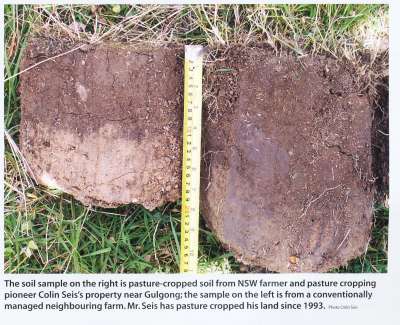There is much debate about the action of atmospheric C02 on climate change. Many scientists who have built their careers on the study of anthropogenic climate change believe that CO2 emitions are responsible for climate change. Others with more open scientific minds, like Erl Happ from Happs Wines in Dunsborough, has spend 2 years studying the subject as an extension of his understanding of the management of his vineyard and has written an excellent paper on the subject which attributes climate change to the activity of the sun.
Irrespective of the effect of CO2 on climate change, a key element of organic farming is the adoption of practices that result in an increase
of soil organic matter. This organic matter provides colloids that hold onto soluble nutrients rather than have them leach down below the root
zone and become lost to production. Soil organic matter also increases the water holding capacity of the soil allowing growth for longer in dry
seasons.
The use of artificial fertilisers, in particular nitrogen fertilisers tends to burn of soil organic matter, this releases carbon from the soil to
the air as CO2. Animal grazing management has a major part to play in managing soil carbon and health, as explained by Bruce Ward of
Holistic Results. The respected ABC Country Hour reports that since adopting Holistic Management techniques a beef farming couple is not overly
concerned about all the climate change hype. The recent drought conditions didn't cause them too many problems either
.
The increase in soil organic matter through organic agricultural practices has the potential to sequest billions of tones of CO2.  According to Andre Leu, Five Billion Hectares of agricultural land, if converted to organic practices, can sequester 37 Gigatonnes of CO2 per annum - nearly all the worlds CO2 output. ( Leu A. 2010)
According to Andre Leu, Five Billion Hectares of agricultural land, if converted to organic practices, can sequester 37 Gigatonnes of CO2 per annum - nearly all the worlds CO2 output. ( Leu A. 2010)
The Highly respected Australian Government Scientific Organisation CSIRO, reports in their ECOS magazine that
Offsets from increased soil carbon on Farmlands are eligible for generation of carbon offset credits under the federal governments National Carbon Offset Standard(NCOS) (Barcley A , 2010)
Barcley reports that between there has been a loss of between 30% and 70% of soil carbon under cultivation compared to uncultivated conditions.
Over 30 studies by diferent research organisations point to co2 sequestration by bio-agriculture, as indicated in the table below (www.bio-agriculture.org , 2010)
| Summary of Research Results | ||
|---|---|---|
| Field Trials | Details | Sequesreation Rate (tonnes CO2 ha/yr) |
| Rodale Institute USA 1981-2005 | - Organic with compost, cover crops rotation, no till -Conventional with mineral fertalizer | 11.01 tonnes/ha/yr 0.8 tonenes/ha/yr |
| DOK Switzerland 1977-2005 | -Biodynamic, compposted farmyard manure -Conventional with mineral fertalizer | 2.75 tones/ha/yr -0.75 tonenes/ha/yr |
| NEC. Jarna Sweden, 1958-1990 | -Biodynamic, ley,compposted farmyard manure -Conventional with mineral fertalizer, no lay | 2.0 tonnes/ha/yr 0.01 tonnes/ha/yr |
| GRDC, DPI Vic, Australia 1998-2007 | -14 irrigation farms, high organic matter input -14 Conventional irrigation farms | 3.96 tonnes/ha/yr 0% |
